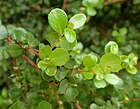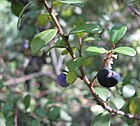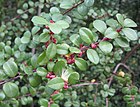Note: This is a project under development. The articles on this wiki are just being initiated and broadly incomplete. You can Help creating new pages.
Difference between revisions of "Myrsine africana"
| Line 1: | Line 1: | ||
[[File:Myrsine africana, vrugte en loof, Elandsfontein, a.jpg|thumb|right|'''Myrsine africana''']] | [[File:Myrsine africana, vrugte en loof, Elandsfontein, a.jpg|thumb|right|'''Myrsine africana''']] | ||
| − | '''Myrsine africana''' | + | '''Myrsine africana''' is also called Cape myrtle. It is a species of shrub in the family Primulaceae. It is indigenous to Macaronesia, Africa and South Asia. It typically has dense, dark-green to red foliage and produces tiny bright purple berries. |
==Uses== | ==Uses== | ||
| − | {{Uses| | + | {{Uses|Dropsy}}, {{Uses|Colic}}. |
==Parts Used== | ==Parts Used== | ||
| Line 8: | Line 8: | ||
==Chemical Composition== | ==Chemical Composition== | ||
| − | Lead (0.291 mg Kg-1), cadmium (0.780 mg Kg-1), chromium (0.172 mg Kg-1) and cobalt was found maximum in root parts whereas iron (414.0 mg Kg-1), zinc (68.33 mg Kg-1) and copper (60.33 mg Kg-1) was recorded in leaves. | + | Lead (0.291 mg Kg-1), cadmium (0.780 mg Kg-1), chromium (0.172 mg Kg-1) and cobalt was found maximum in root parts whereas iron (414.0 mg Kg-1), zinc (68.33 mg Kg-1) and copper (60.33 mg Kg-1) was recorded in leaves.<ref name="chemical composition"/> |
| − | <ref name="chemical composition"/> | ||
==Common names== | ==Common names== | ||
| − | {{Common names|kn=|ml=|sa= | + | {{Common names|kn=|ml=|sa=Vidanga|ta=|te=|hi=Bandraru oleander, Banwa|en=Cape Myrtle, African }} |
==Properties== | ==Properties== | ||
| Line 35: | Line 34: | ||
==Identification== | ==Identification== | ||
===Leaf=== | ===Leaf=== | ||
| − | {{Leaf|Simple| | + | {{Leaf|Simple|Round in outline|The fine-toothed leaves are at first deep red, but on maturity become glossy and dark green.}}<ref name="Leaf"/> |
===Flower=== | ===Flower=== | ||
| − | {{Flower|| | + | {{Flower||Small|Cream white turns to red||Separate shrubs produce either male or female flowers, with the female plants producing purple berries. The hardy plant is long-lived.}} |
===Other features=== | ===Other features=== | ||
| Line 49: | Line 48: | ||
==How to plant/cultivate== | ==How to plant/cultivate== | ||
| − | A plant of the drier tropics and subtropics, where it is found at elevations up to 3,800 metres. | + | A plant of the drier tropics and subtropics, where it is found at elevations up to 3,800 metres.<ref name="How to plant/cultivate"/> |
| − | <ref name="How to plant/cultivate"/> | ||
==Commonly seen growing in areas== | ==Commonly seen growing in areas== | ||
| − | {{Commonly seen| | + | {{Commonly seen|Tropical zones}}. |
==Photo Gallery== | ==Photo Gallery== | ||
Revision as of 12:54, 25 June 2020
Myrsine africana is also called Cape myrtle. It is a species of shrub in the family Primulaceae. It is indigenous to Macaronesia, Africa and South Asia. It typically has dense, dark-green to red foliage and produces tiny bright purple berries.
Contents
- 1 Uses
- 2 Parts Used
- 3 Chemical Composition
- 4 Common names
- 5 Properties
- 6 Habit
- 7 Identification
- 8 List of Ayurvedic medicine in which the herb is used
- 9 Where to get the saplings
- 10 Mode of Propagation
- 11 How to plant/cultivate
- 12 Commonly seen growing in areas
- 13 Photo Gallery
- 14 References
- 15 External Links
Uses
Parts Used
Chemical Composition
Lead (0.291 mg Kg-1), cadmium (0.780 mg Kg-1), chromium (0.172 mg Kg-1) and cobalt was found maximum in root parts whereas iron (414.0 mg Kg-1), zinc (68.33 mg Kg-1) and copper (60.33 mg Kg-1) was recorded in leaves.[1]
Common names
| Language | Common name |
|---|---|
| Kannada | |
| Hindi | Bandraru oleander, Banwa |
| Malayalam | |
| Tamil | |
| Telugu | |
| Marathi | NA |
| Gujarathi | NA |
| Punjabi | NA |
| Kashmiri | NA |
| Sanskrit | Vidanga |
| English | Cape Myrtle, African |
Properties
Reference: Dravya - Substance, Rasa - Taste, Guna - Qualities, Veerya - Potency, Vipaka - Post-digesion effect, Karma - Pharmacological activity, Prabhava - Therepeutics.
Dravya
Rasa
Guna
Veerya
Vipaka
Karma
Prabhava
Habit
Identification
Leaf
| Kind | Shape | Feature |
|---|---|---|
| Simple | Round in outline | The fine-toothed leaves are at first deep red, but on maturity become glossy and dark green. |
Flower
| Type | Size | Color and composition | Stamen | More information |
|---|---|---|---|---|
| Small | Cream white turns to red | Separate shrubs produce either male or female flowers, with the female plants producing purple berries. The hardy plant is long-lived. |
Other features
List of Ayurvedic medicine in which the herb is used
Where to get the saplings
Mode of Propagation
How to plant/cultivate
A plant of the drier tropics and subtropics, where it is found at elevations up to 3,800 metres.[3]
Commonly seen growing in areas
Photo Gallery
References
External Links
- Ayurvedic Herbs known to be helpful to treat Dropsy
- Ayurvedic Herbs known to be helpful to treat Colic
- Herbs with Fruits used in medicine
- Herbs with Leaves used in medicine
- Herbs with common name in Hindi
- Herbs with common name in Sanskrit
- Herbs with common name in English
- Habit - Long Herbs
- Index of Plants which can be propagated by Seeds
- Herbs that are commonly seen in the region of Tropical zones
- Herbs
- Myrsinaceae




